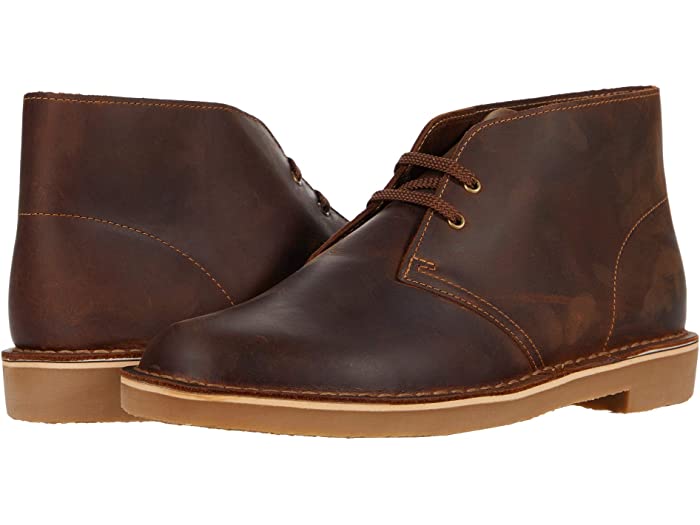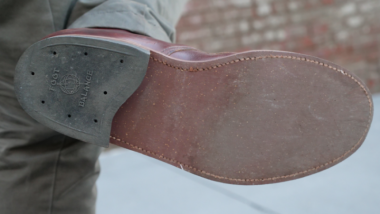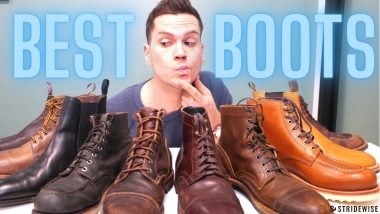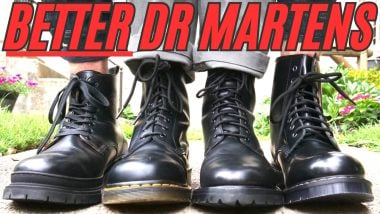Types of Boot Soles You Should Know About: Rubber vs Leather vs Crepe
If you’re dropping real money on your boots, you want to make sure you have the best type of boot soles for your style and use. Just like you wouldn’t wear flip-flops while mountaineering or dress shoes at the beach, not every sole suits every situation; each type has its strengths and limitations, and understanding those trade-offs is key to choosing the right boot sole for your needs.
To break it all down, I visited shoemaker David Corey at Oldspeed MFG in his Pennsylvania workshop. We’re taking a close look at how different soles stack up in terms of shock absorption, break-in, durability, grip, stability, weight, and breathability. We’ll start with common materials before moving into tread patterns and styles.
Crepe Soles vs. Leather Soles vs. Rubber Soles
Here’s a quick overview of the three common boot sole materials and how they perform. After that, we’ll go deeper into specific types and brands.
| Crepe Sole | Rubber Sole | Leather Sole | |
| Shock absorption | High | High | Low |
| Weight | Light | Depends on thickness | Light |
| Flexibility | High | Depends on thickness | High |
| Break In | Easy | Depends on thickness | Easy |
| Grip (when dry) | High | High | Low |
| Breathable | No | No | Yes |
| Durability | Low | High | Low |
| Stablility | Low | High | High |
| Groundfeel | Moderate | Low | High |
| Insulates against cold ground | Moderate | Yes | No |
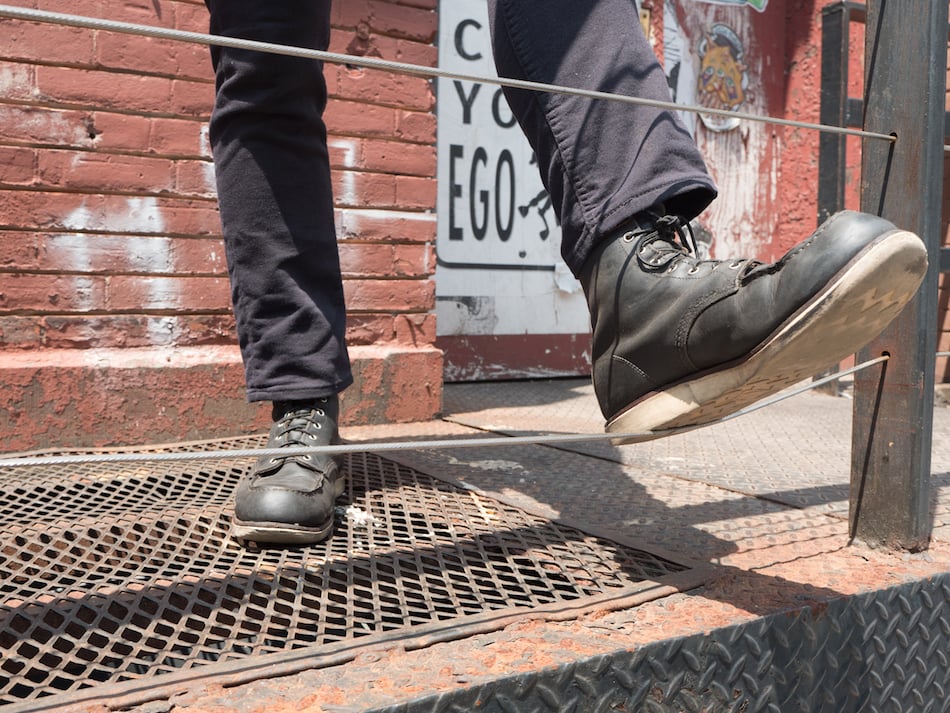
1. Crepe Rubber Soles
I met up with David for this piece in part because he frequently uses crepe rubber in his boots — a rare choice in the world of heavy-duty footwear. “I love using crepe,” he says. “It’s a really nice material. Crepe is super lightweight. Compared to something like Vibram or Dr. Sole, which are thick and heavy, a crepe sole makes the whole boot much lighter.”
Crepe rubber is very soft and squishy, which can be a pro or a con depending on how and where you wear your boots. “Some people really value stability, while others prefer the softness,” Dave explains. “When I build a pair with a crepe sole, I make the heel wider because I know people worry about rolling their foot. It’s super flexible and absorbs shock really well.”
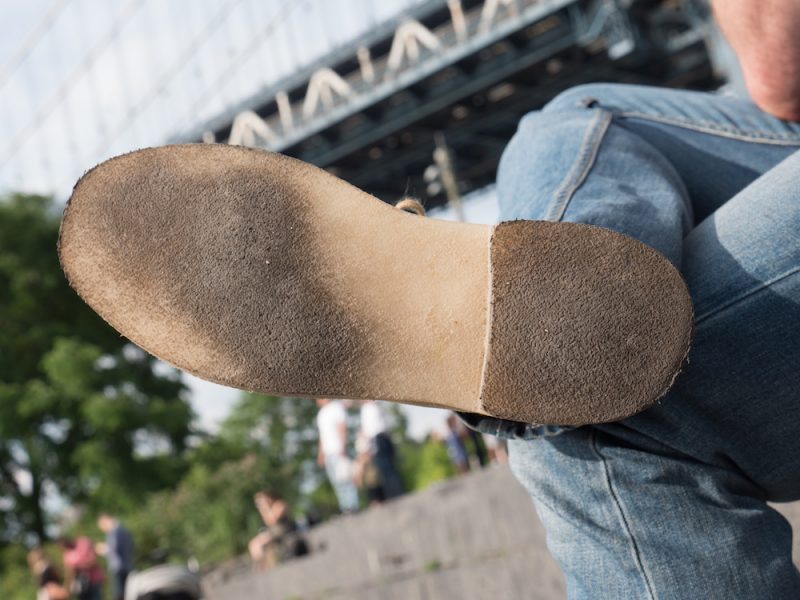
A lot of guys love it for the shock absorption, but it gets unbelievably dirty with wear, it sucks up everything it touches — you’ll find hair and pebbles in it after a day of wear — it slips kind of easily in the wet, and it absorbs water and oil very easily. They’re for desert boots, after all, not wet conditions.
But they are soft and comfy.
Crepe Rubber Pros
- Excellent shock absorption
- Very lightweight underfoot
- Highly flexible and cushioned
- Minimal break-in required
- Decent grip on dry surfaces
Developed in WW2, this wartime staple is now a style icon. It is simple, comes in countless colorways to suit any style, and the crepe sole makes this chukka very comfortable.
Crepe Rubber Cons
- Not breathable — retains heat and moisture
- Wears down relatively quickly
- Less stable, especially on uneven terrain or with heavy loads

2. Leather Soles
Leather soles are an underrated option. “They’re generally cheaper to resole, very lightweight, and super flexible,” says Dave. “They also offer excellent ground feel — after walking all over New York City in a pair of leather-soled Wolverine 1000 Miles, I could really feel the pavement in a good way.”
It’s also the oldest and dressiest of all soles: bootmakers have used leather soles for thousands of years. Vegetable-tanned leather is the go-to for soles because it’s durable and stiff, so it won’t wear out quickly or crack.
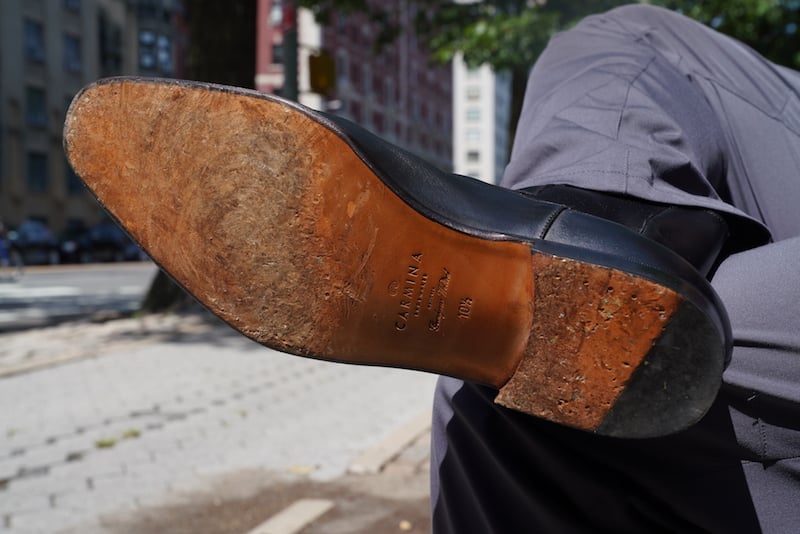
“Leather gives you the easy break-in and everyday comfort of crepe, with some of the stability you’d expect from rubber,” Dave explains. “It lands right in the middle, which is why cowboy boots often use leather soles for breathability in hot, dry climates, and loafers frequently rely on them for lightweight, flexible comfort.”

Leather soles are softer and break in more easily than dense rubber. Many people overlook how much the outsole affects break-in. “A loafer with a JR leather sole is going to be super comfortable right out of the box,” Dave points out. “While a double sole on a rugged boot may be tougher to break in, leather generally beats rubber in this category.”

The trade-offs: leather soles wear out faster, don’t absorb much shock, and aren’t great in cold weather. “If the ground’s really cold,” Dave says, “I’d go with the thickest rubber sole I can get. Leather and crepe absorb the cold — it’s uncanny.”
Grip is also a weak point — leather soles can be slippery, especially when new or in wet conditions, making them less ideal for rain or snow.
Now, they scratch up as you wear them in, which confers more grip, but the shoes are not as smooth and dressy. And that does confer more grip. But then you’ve got ugly soles that all of a sudden don’t look that dressy.
Further Reading
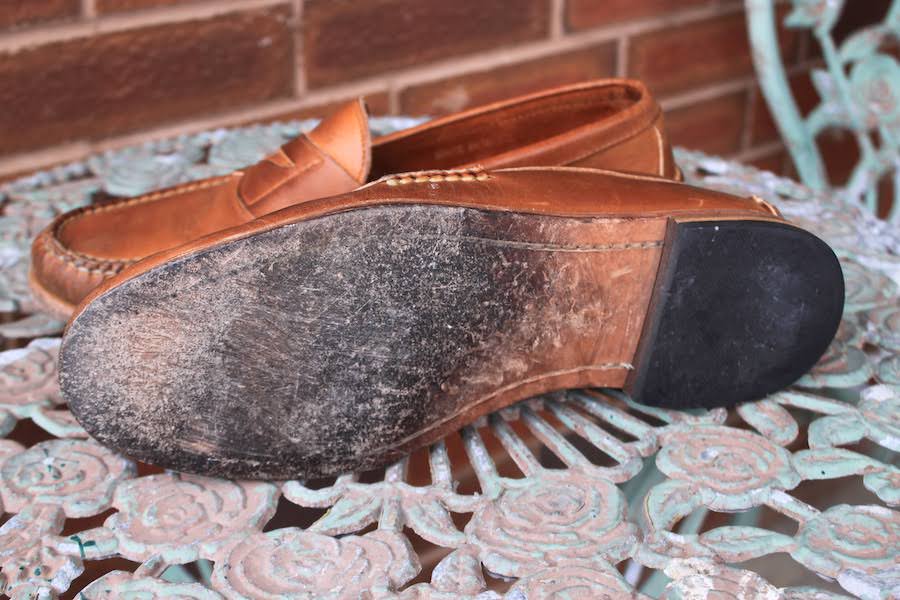
The Pros and Cons of Leather Boot Soles
Leather soles are harder-wearing than you think! Learn more →
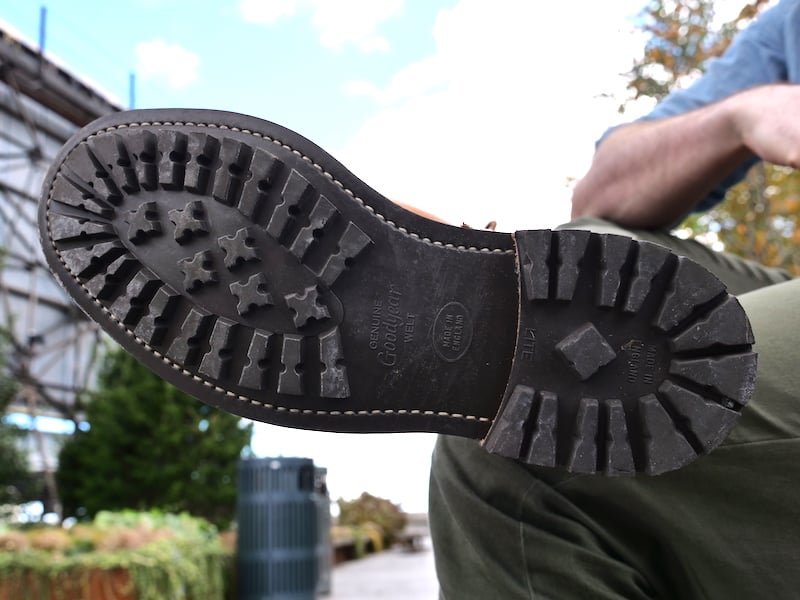
3. Rubber Soles
Most shoes come with rubber soles, with Vibram being the most well-known brand. Other popular options include Dainite and Dr. Sole, a Taiwanese brand.
This dense rubber is the go-to for most people, and for good reason. “Rubber soles offer great performance in wet conditions, depending on the type,” says Dave. “You can’t really add tread to crepe, but with rubber, you can do pretty much whatever you want on the bottom.”

A classic example is the Vibram 430: a solid nitrile rubber sole with a tank-like tread that offers excellent grip in snow, ice, and rain, a major advantage over crepe or leather soles.
Dense rubber soles are much more durable. “It’s definitely tougher to wear down,” Dave says. “It lasts a lot longer. It doesn’t absorb shock as well, but it’s still fairly flexible, and it breaks in nicely.”
So with this type of sole, you get better grip, better rain performance, and longer lifespan — but you give up some softness and shock absorption. It’s heavier, less flexible, and not breathable.
Rubber Sole Pros
- Excellent grip, even in wet or slippery conditions
- Very durable and long-lasting
- Performs best in cold, wet, or harsh weather
Rubber Sole Cons
- Limited shock absorption compared to softer soles
- Stiffer feel; longer break-in period
- Not breathable — can trap heat and moisture
- Typically more expensive, especially for branded options like Vibram
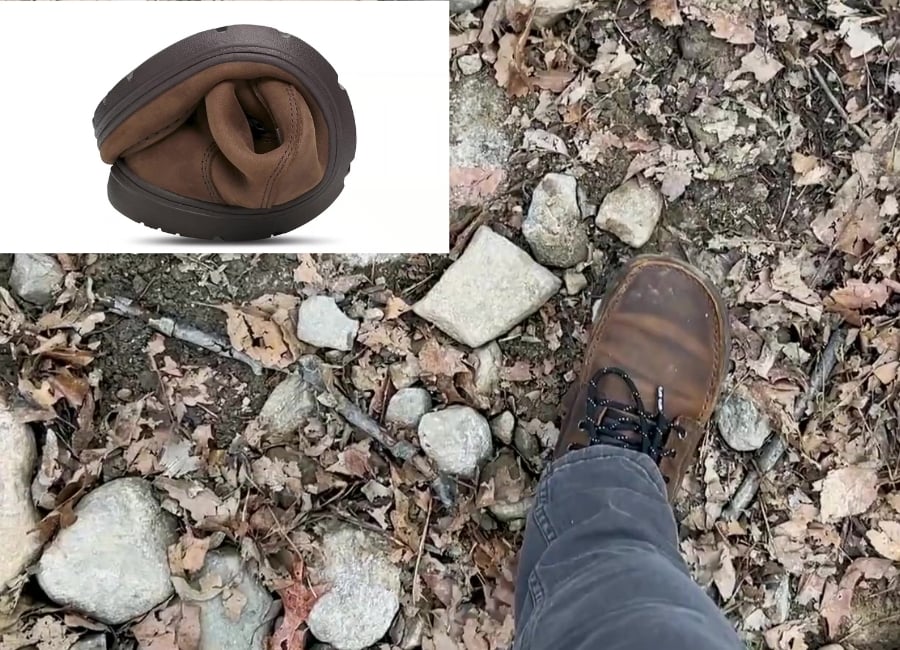
4. Injection Blown Rubber Soles
Injection-blown rubber (IBR) is a mix of air and rubber that results in an exceptionally lightweight material. When used for the outsole, it helps create shoes that are lighter and more flexible than those with traditional full-rubber soles.
The trade-off is that IBR outsoles tend to wear down faster, so they may not last as long under heavy or frequent use. Whether that’s a downside depends on your needs — some people prioritize lightness and flexibility over maximum durability.
You’ll often find IBR on more casual footwear, lightweight boots, and minimalist or zero-drop styles like Lems Boulder boots, as well as on some wedge soles, like Vibram’s super popular Christy sole.

Injection-Blown Rubber (IBR) Sole Pros
- Extremely lightweight, reducing overall shoe weight
- Offers greater flexibility for natural movement
- Comfortable underfoot feel, especially for casual or minimalist footwear
- Commonly used in zero-drop and barefoot-style shoes
Injection-Blown Rubber (IBR) Sole Cons
- Less durable than full-rubber soles — wears down faster under frequent or heavy use
- Not ideal for high-impact or rugged conditions
- Provides less structure and support compared to denser sole materials
- Limited traction in some environments depending on tread design
5. Raw Cord Soles
Originally developed during World War II due to material shortages, raw cord soles were introduced to meet the demand for oil-resistant combat boots. Dr. Sole has revived this construction, drawing inspiration from the cork soles of the U.S.N. N-1 “Field Boot.”
Their modern version, the 1122, features a nitrile rubber compound enhanced with pulverized hemp cord. This not only evokes a vintage look but also improves grip and traction. Additional upgrades include better durability, improved shock absorption, and reduced weight.
Raw Cord Sole Pros
- Pulverized hemp cord embedded in the rubber provides strong grip, especially on flat or slippery surfaces
- Very hard-wearing compound built to handle heavy use
- Authentic visual appeal, especially for WWII-inspired or heritage-style boots
- Aesthetically and functionally suited to heavy-duty boots like Viberg Boondockers
Raw Cord Sole Cons
- Heavier than many other outsoles, including Dainite and most Vibram options
- Less flexible, especially when new, may lead to fatigue or discomfort for some wearers
- Not the best for casual for all-day wear due to weight and rigidity
- Best suited to rugged or niche use cases rather than everyday casual wear
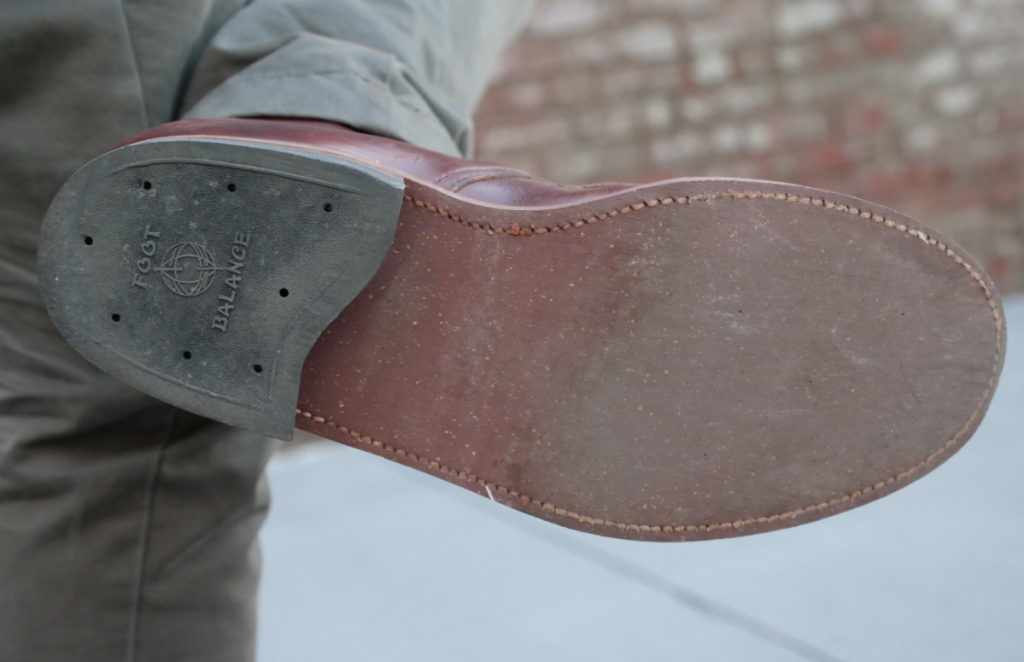
6. Cork Nitrile Soles
Cork Nitrile is a composite material made from rubber blended with approximately 20% to 40% cork. The cork component is often sourced from recycled materials, such as leftover cork from wine stoppers or insoles. In addition to reducing weight, cork can offer a bit of extra cushioning, which may improve underfoot comfort compared to soles made entirely of rubber.
A lot of boot guys probably got their first introduction to cork nitrile soles from old school Red Wing Iron Rangers (some insist they were better with cork nitrile soles).
The most popular cork nitrile soles are from Dr. Sole, which offers a full line of cork nitrile soles and half soles with flat bottoms or their patented Super-Grip tread pattern.
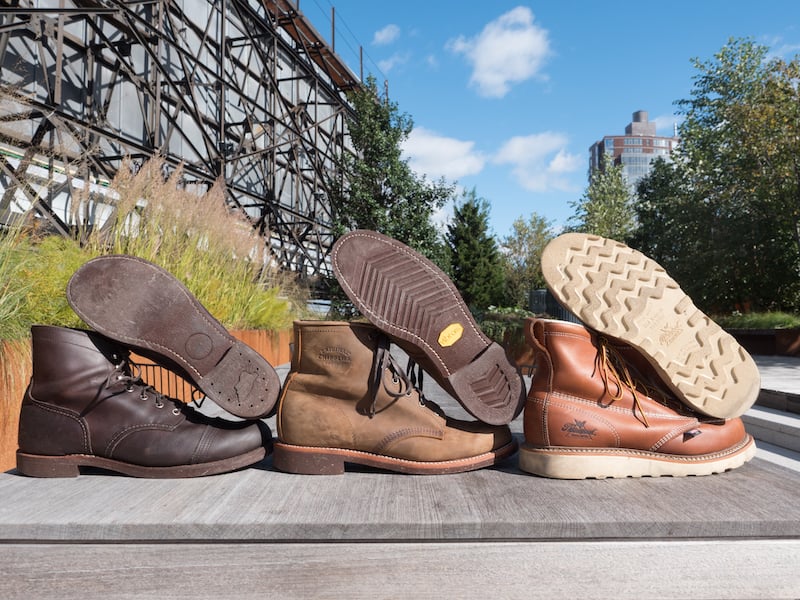
Cork Nitrile Pros
- Available in flat bottoms for a clean look or with Dr. Sole’s Super-Grip tread for added traction
- Cork nitrile compound balances flexibility and wear resistance
- Cork adds some shock absorption and lightness compared to full rubber
Cork Nitrile Cons
- May not be stocked by all cobblers — sourcing depends on local inventory
- Less grippy than deep-lug soles, especially in cold weather when they harden
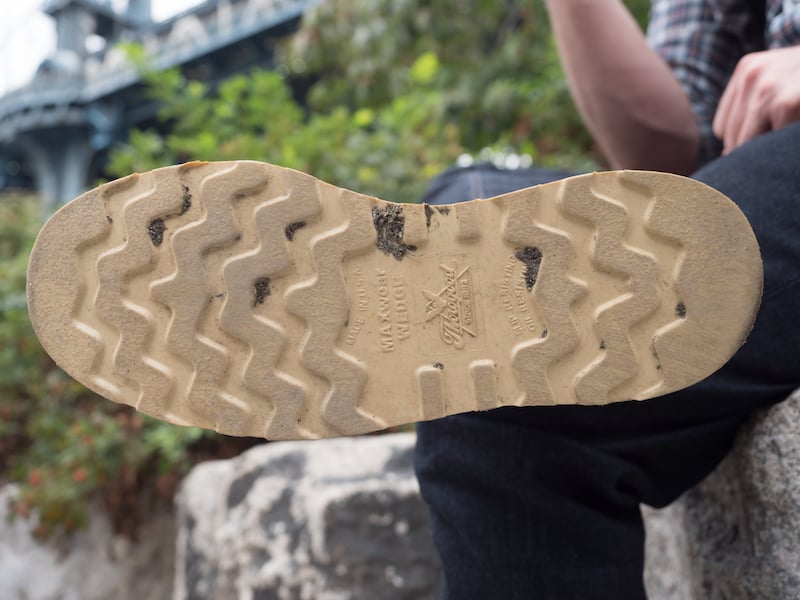
7. Polyurethane
Often, bootmakers use polyurethane wedge soles on work boots like the Thorogood Heritage work boot pictured above.
Relative to softer rubber, like crepe soles, polyurethane soles tend to be a bit more work-friendly — they’re often certified by OSHA, and resistant to electrical shock. It tends to be a bit harder and has more longevity than the softer crepe rubber.
Polyurethane (PU) Soles Pros
- PU soles are more resistant to wear than softer rubber alternatives like crepe
- Commonly used in safety and work boots due to compliance with OSHA standards
- Provides a balance of firmness and comfort, especially for standing or walking on hard surfaces
- PU resists many workplace hazards that can break down other sole materials
- Performs consistently in both hot and cold environments
Polyurethane (PU) Wedge Soles Cons
- Can feel stiffer than blown rubber or crepe soles, especially when new
- While cushioned, it’s not as plush as blown rubber or EVA
- PU can degrade or become brittle with age, especially in dry or hot climates if not worn regularly
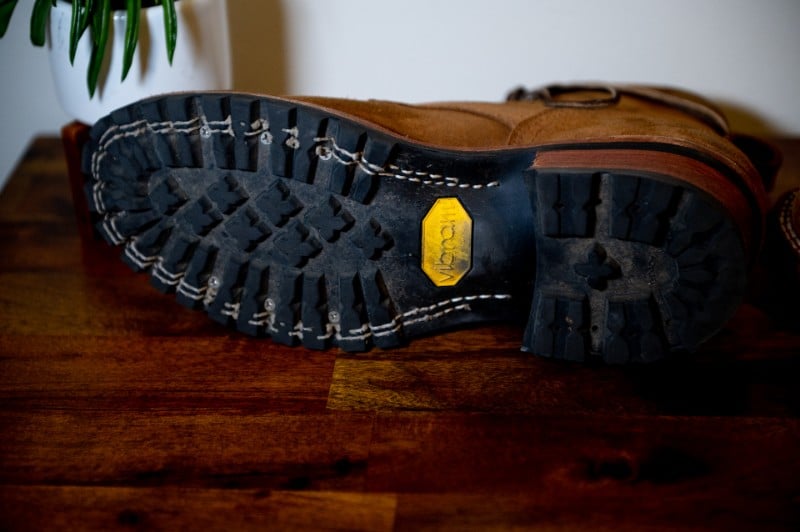
8. Lug Soles
Vibram released the Carrarmat lug sole in 1937. Since then, they’ve been incredibly popular with outdoorsy types of all flavors, and they’re still everywhere today.
Lug soles are what many associate with functional boots; they’re clunky and give your boots a rugged, outdoorsy profile with pronounced lugs or treads (like a tire).
They give you extra traction on all kinds of surfaces and weather conditions, though they can also trap mud and rocks and make a mess. These are some of the most informal of all boot soles.

Lug Sole Pros
- Excellent traction on a variety of surfaces, including wet and uneven terrain
- Very durable and long-lasting
- Ideal for outdoor use and harsh weather conditions
Lug Sole Cons
- Can trap mud, rocks, and debris
- Heavier and bulkier than other sole types
- Less formal in appearance — strongly associated with casual or outdoor wear
- May require a longer break-in period due to stiffness
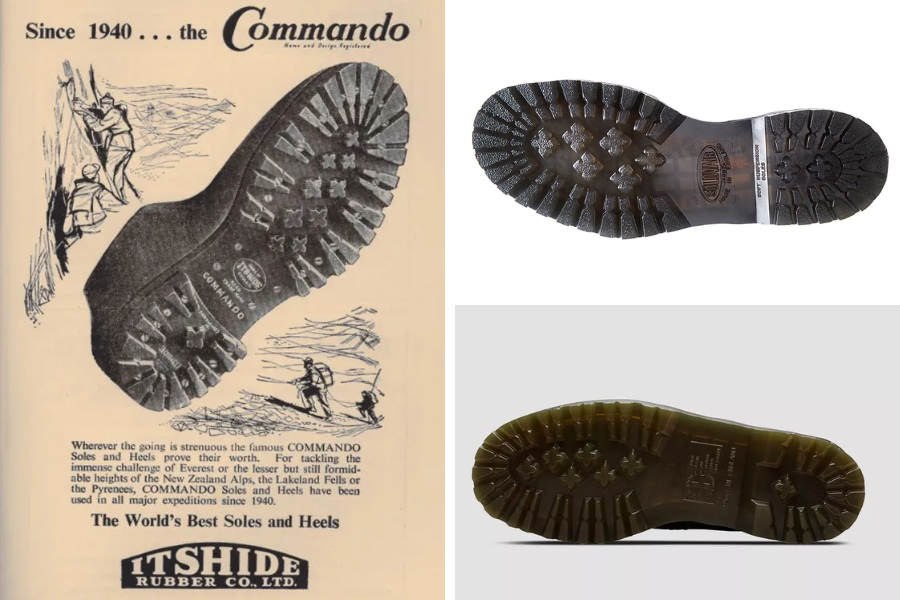
9. Commando Soles
Commando soles are generally considered a type of lug sole that was created by now-defunct British sole maker Itshide in 1940. They have a very aggressive lug but are springy and shock-absorbent. Dr. Martens and NPS Solovair make commando soles that offer the combination of bounce and thick lugs.
Commando Soles Pros
- Deep, aggressive lugs provide a strong grip on a variety of surfaces, including mud, gravel, and wet ground
- Despite their rugged look, many commando soles have a degree of spring or bounce that improves comfort during walking
- Built for heavy wear and harsh conditions, they resist abrasion well and hold up over time
Commando Soles Cons
- Adds noticeable weight to the boot, which can lead to fatigue over long wear
- The bulky tread makes them less appropriate for formal or streamlined looks
- Deep lugs are prone to collecting mud, rocks, or snow
- The thickness and lug depth can reduce sensitivity underfoot, which some users may dislike for daily wear
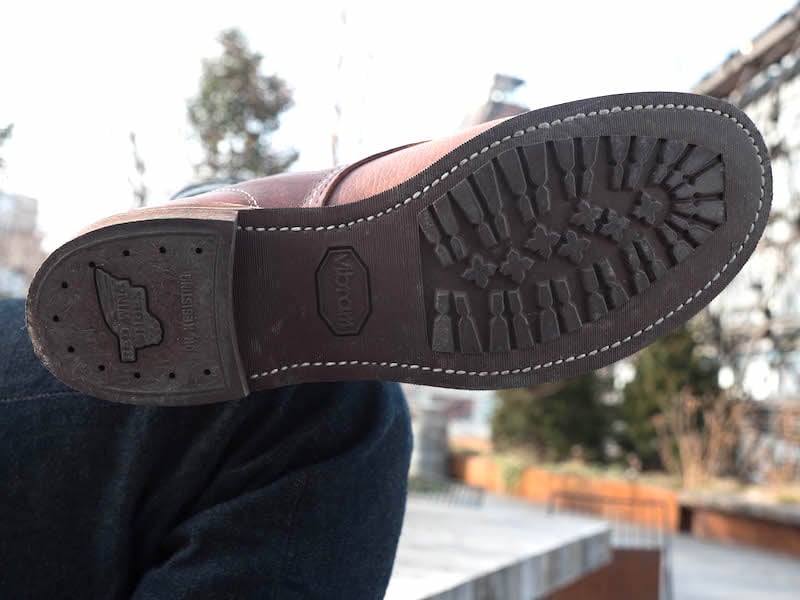
10. Mini-Lug
While we’re on the subject of flat but grippy, let’s talk about mini lugs. They have slightly smaller lugs, which are placed in pairs.
The Vibram Mini Lugs are on all modern versions of the Iron Ranger and Blacksmith from Red Wing, along with many other brands, like the newer Ranch boot from Taylor Stitch.
Like the Ridgeway, this rubber sole confers good grip and a low profile; it’s cheaper to make an example than Dainite — it’s one of the finer combinations of style and utility and perhaps the grippiest low-profile sole.
Mini Lug Soles Pros
- Provides solid traction while maintaining a sleeker silhouette than traditional lug soles
- Works well with casual and dress-casual boots — a good middle ground between aesthetics and performance
- Smaller lugs are less likely to trap rocks, mud, or snow compared to full lugs or commando soles
- Grippiest among low-profile soles
Mini Lug Cons
- Not suitable for rough terrain, deep mud, or heavy-duty outdoor use
- Less cushioning compared to blown rubber or wedge soles — some users may find them firm
- Designed more for urban and light outdoor use than industrial or off-road environments
- May appear more rugged in certain contexts where a cleaner profile is preferred
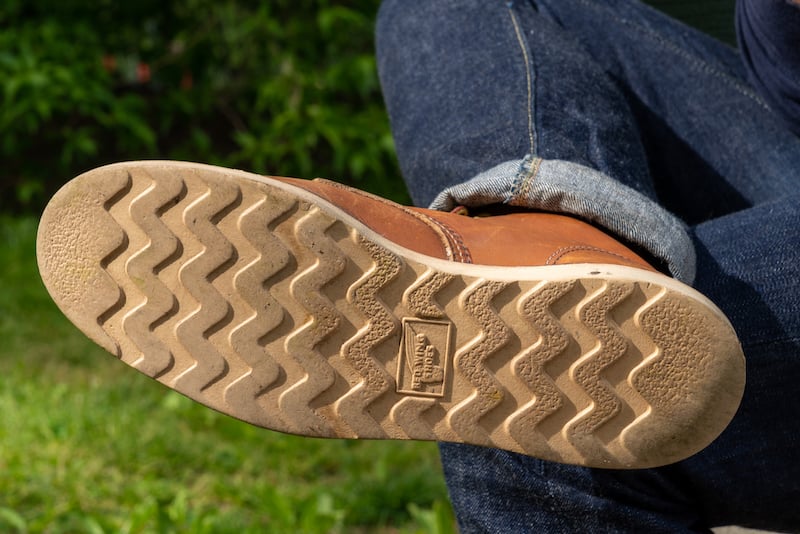
11. Wedge Soles
Like lug and mini lug soles, wedge soles are not a type of material but rather a style. These boots are typically one flat piece of rubber, so there’s more contact with the ground.
The idea of wedge soles is that, besides usually being softer and a bit more sneaker-like than heeled boots, they help avoid tripping hazards and track less mud. So, while they look more modern and sneaker-like, they’re very popular on work boots today.
Wedge soles are often made of lighter materials like crepe, blown rubber or polyurethane.
The classic 4014 Christy Wedge sole by Vibram is a popular blown wedge sole. Brands have increasingly moved to using in-house soles (Red Wing and Thorogood are two examples). You’ll find them on JK Boots, Thursday’s Diplomat, and Grant Stone’s Garrison boot.
Wedge Sole Pros
- Flat sole provides consistent surface contact, offering stability and even weight distribution
- No heel break means fewer chances of catching edges on uneven surfaces — ideal for worksites and flat terrain
- Often made from softer or more cushioned materials like crepe, blown rubber, or polyurethane, which absorb shock well
- Sneaker-like feel that’s more forgiving and flexible than traditional heeled boots
- Flat profile means less mud, dirt, and rocks get lodged compared to deep lug soles
Wedge Sole Cons
- Flat soles offer less grip on slopes, loose gravel, or wet outdoor surfaces compared to lug or commando soles
- Softer materials like crepe and blown rubber may break down more quickly under heavy use
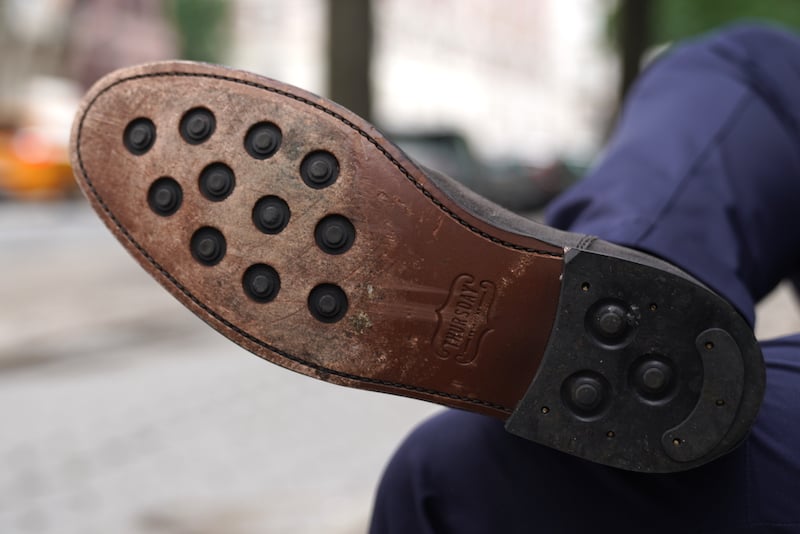
12. Studded Sole
Dainite makes the most common studded soles on the market. The Harboro Rubber Co., owner of Dainite, debuted its version all the way back in 1910, and the most popular among shoe aficionados.
The sole’s grippy recessed lugs provide grip with a sleek flat appearance, and while it looks hyper-modern Today, it appears on higher-end (read: over $350) boots like the Higgins Mill and the Viberg Service Boot.
They are a great compromise on grip, aesthetics, flexibility, and durability. With recessed lugs that are their trademark, these boots have a smoother line and far better traction than a flat leather sole.
It’s worth noting that while Dainite is the inventor and popularizer of this kind of recessed-lug sole, they’ve inspired countless other brands. The Thursday boot has a really cool custom studded rubber sole, as does the Grant Stone Chelsea, without the heftier price tag of Dainite.

Studded Rubber Soles Pros
- Offers a strong mix of grip, flexibility, durability, and aesthetics
- The small, low-profile studs improve traction on wet or smooth surfaces without compromising visual sleekness
- Flat, minimally patterned surface gives a refined look — ideal for dress boots and high-end casual styles
- Suitable for both professional and casual wear
Studded Rubber Soles Pros
- While grippy, recessed lugs aren’t built for deep mud, snow, or hiking-grade use
- Offers less shock absorption than crepe, blown rubber, or wedge soles
[Related: Why Do All the Good Boots Have Dainite Soles?]
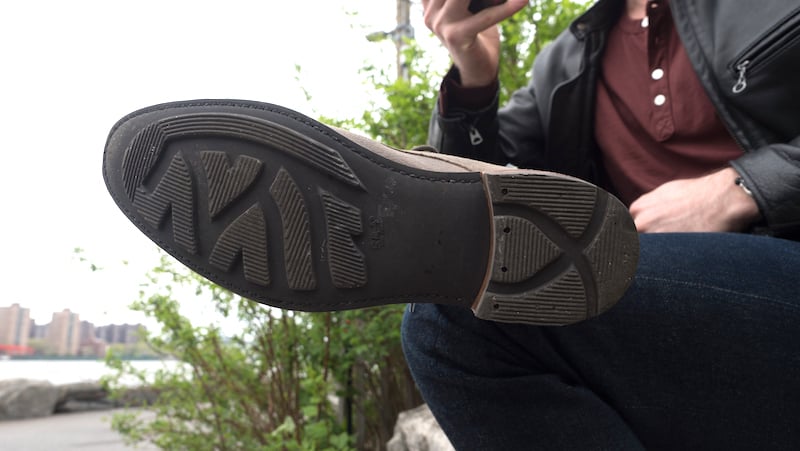
13. Ridgeway Sole
Haboro, the same company that makes the Dainite sole, also produces the Ridgeway sole. I’ll quickly touch on this one since it’s not all that common.
It was named after the Ridgeway Trail in England. Dainite recognised a growing trend for recreational walking and created this sole in 1941. The tread pattern is meant to provide traction on the varied terrain. The idea behind the design is that the curved lugs and ridged channels bend or curve to the shape of the terrain, offering better grip.
Ridgeway soles, like the one you can see above on my Taft Dragon boots, are also nice and flat when viewed from the side. It looks great and provides superior grip and a tiny bit more flexibility, though it’s less dressy than a mini lug.
Ridgeway Soles Pros
- Curved lugs and ridged channels are designed to adapt to uneven surfaces, offering reliable grip for varied terrain
- While more rugged than a flat leather or mini lug sole, Ridgeway still maintains a clean side profile
- A solid choice if you want more traction but don’t want the bulk of a full lug sole
Ridgeway Soles Cons
- Harder to find on most boots; not as widely adopted as other styles
- Slightly more rugged in appearance, making it less suited to formal styles
- Due to limited availability, it may not be as readily available for resoling

14. Half Sole
Half soles are found on a wide range of footwear, from dress shoes to boots. Guys like them because they cut down on weight and make for a sleeker-looking boot or shoe, but you still get the grip from the toe and heel. Also, you have a bit more freedom if you want to go for a partial sole replacement.
Half Soles Pros
- Reduces the overall weight of the boot or shoe compared to full-length soles
- Offers a more refined, low-profile look, especially desirable on dress boots or slim silhouettes
- Provides grip where it’s needed most — at the toe and heel — while maintaining visual simplicity in the midfoot
- Allows for partial sole replacement without redoing the entire outsole, saving time and money
- Found on everything from formal shoes to rugged boots
Half Soles Cons
- The exposed leather or midsole between the heel and the toe can absorb water more easily than a full rubber sole
- Exposes more of the midsole to wear and environmental elements
- Better suited for urban or indoor use than rugged, all-weather environments
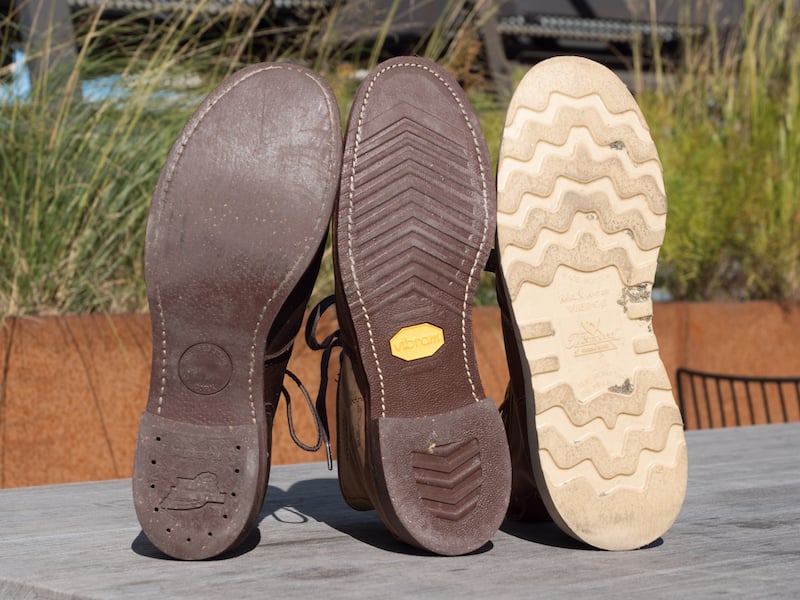
Wrapping Up
Different soles serve different purposes, and we’re not about to say any of them are the “best.” It depends on your own needs: Dainite soles are a great compromise, leather is nice and soft, wedge soles look more modern, and they’re harder to trip in… we could go on. Let us know which sole is your favorite and why!

